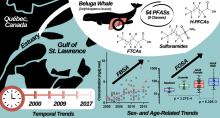| Title | Synthesis and Toxicity Evaluation of -Phenylenediamine-Quinones. |
| Publication Type | Journal Article |
| Year of Publication | 2025 |
| Authors | Nair, P, Sun, J, Xie, L, Kennedy, L, Kozakiewicz, D, Kleywegt, SM, Hao, C, Byun, H, Barrett, H, Baker, J, Monaghan, J, Krogh, ET, Song, D, Peng, H |
| Journal | Environ Sci Technol |
| Date Published | 2025 Apr 08 |
| ISSN | 1520-5851 |
| Abstract | -(1,3-Dimethylbutyl)--phenyl--phenylenediamine-quinone (6PPD-Q), the tire rubber-derived transformation product of 6PPD, was recently discovered to cause the acute mortality of coho salmon (). Aiming to identify potential replacement antiozonants for 6PPD that do not produce toxic quinones, seven PPD-quinones with distinct side chains were synthesized to investigate their structure-related toxicities using rainbow trout (). While 6PPD-Q exerted high toxicity (96 h LC = 0.35 μg/L), toxicity was not observed for six other PPD-quinones despite their similar structures. The fish tissue concentrations of 6PPD-Q after sublethal exposure (0.29 μg/L) were comparable to the other PPD-quinones, which indicated that bioaccumulation levels were not the reason for the selective toxicity of 6PPD-Q. Hydroxylated PPD-quinones were detected as the predominant metabolites in fish tissue. Interestingly, a single major aromatic hydroxylation metabolite was detected for the alternate PPD-quinones, but two abundant OH-6PPD-Q isomers were detected for 6PPD-Q. MS spectra confirmed that hydroxylation occurred on the alkyl side chain for one isomer. The structurally selective toxicity of 6PPD-Q was also observed in a coho salmon (CSE-119) cell line, which further supports its intrinsic toxicity. This study reported the selective toxicity of 6PPD-Q and pinpointed the possibility for other PPDs to be applied as potential substitutes of 6PPD. |
| DOI | 10.1021/acs.est.4c12220 |
| Alternate Journal | Environ Sci Technol |
| PubMed ID | 40197014 |
Environmental Chemical Biology

